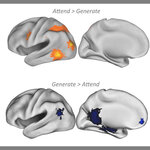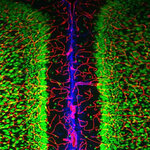Neuroscience

A new study demonstrates that the atypical trajectory of cortical/brain development in autism spectrum disorder (ASD) extends well beyond young childhood and into late adolescence and young adulthood.
A considerable amount of work has focused on early structural brain development in ASD utilizing magnetic resonance imaging (MRI). This body of work has revealed evidence for brain overgrowth during the early postnatal years that appears largely absent later in development in ASD. Although several studies of cortical brain structure in adolescence and young adulthood in ASD have been completed,…

Gaze following to distant space has been documented in many species such as primates, domesticated goats, several bird species, dolphins, fur seals, the red-footed tortoise and wolves. Gaze following is therefore a basic response found in many taxa. Dogs may present a special case as we find evidence that they are able to follow human gaze to objects such as food or toys, but not for the comparatively simpler task of following gaze into distant space.
Two possible reasons were offered to explain this phenomenon: One reason could be habituation. Dogs lose their innate gaze following response…

Real-time brain scans coupled with a machine-learning algorithm can reveal whether a person has memory of a particular subject, but with a little bit of concentration people can easily hide their memories from the computer.
Memory is obviously important, in areas like eyewitness testimony, medicine and even marketing. Programs that can read a person's brain scan data and surmise whether that person is experiencing a memory could be important for those reasons.
But with just a little bit of coaching and concentration, subjects are easily able to obscure real memories, or even create…

Humans can discriminate tens of thousands of odors. While we may take our sense of smell for granted, it adds immeasurably to our quality of life: the aroma of freshly brewed coffee; the invigorating smell of an ocean breeze or a field of wildflowers; the fragrance of a lover or the natural smell of a baby.
Our olfactory sense also warns us when milk turns rancid, when a baby’s diaper needs changing and when there’s a gas leak. In animals, the sense of smell is essential for detection of predators and other dangers, food sources and mates.
How this amazing sense works to discriminate odors…
Some blind individuals use echoes from tongue or finger clicks to recognize objects in the distance, such echolocation can almost be a radar 'replacement' for vision.
Recent research showed that echolocation in blind individuals is a full form of sensory substitution, and that blind echolocation experts recruit regions of the brain normally associated with visual perception when making echo-based assessments of objects.
Just like multiple properties (size, expected weight, texture, composition) of an object assessed by visual cues are encoded in different brain regions, recent lab…

Do we hear sounds as they are, or do our expectations about what we are going to hear shape the way sound is processed?
Through the use of computational neuroscience models, Bournemouth University’s Dr. Emili Balaguer-Ballester and colleagues are trying to map the way that the brain processes sound.
For example, it takes hundreds of milliseconds for sound to be processed along the neurons from the ear to the brain, yet we can recognize the sex of a speaker or a melody after just a few milliseconds. Researchers are combining magneto and electroencephalography to map brain activity…

A study of 2,377 children with autism, their parents and siblings - data from families with one child with autism and one or more children without the condition - has led to new information on how different types of mutations affect autism risk.
The genetic data was obtained from exome sequencing, which looks at only the protein-coding portions of the genome and came from families participating in the Simons Simplex Collection and from the Simons Foundation Autism Research Initiative, including millions of genetic variants, and has been made freely available to other autism researchers.…

Researchers have discovered that a brain protein plays a key role in controlling binge drinking, defined as drinking to the point of intoxication. They found that deleting the gene for this protein in mice ramped up alcohol consumption and prevented the brain from signaling the rewarding properties of alcohol.
The goal of the new study was to identify the role of a member of the "G protein-gated inwardly rectifying potassium channel" (GIRK) family in the behavioral and cellular responses to alcohol.
GIRK channels are distributed throughout the nervous system, where they decrease the…

Your genes may influence how sensitive you are to emotional information, according to a new study which found that carriers of a certain genetic variation perceived positive and negative images more vividly, and had heightened activity in certain brain regions.
The gene in question is ADRA2b, which influences the neurotransmitter norepinephrine. The ADRA2b deletion variant appears in varying degrees across different ethnicities. Although roughly 50 percent of the Caucasian population studied by these researchers in Canada carry the genetic variation, it has been found to be prevalent in other…

It's been known since the 16th century that neurons and blood vessels often traverse the body side by side but it was only more recently discovered that the growth of neuronal and vascular networks is controlled by the same molecules.
“Most interesting is the interaction between neurons and blood vessels in the cerebral cortex. To date, we know very little about how neurons communicate with endothelial cells in order to structure a functional network in the brain.” explains Prof. Dr. Amparo Acker-Palmer, who plans to assess these processes in the layering of the cerebral cortex during…